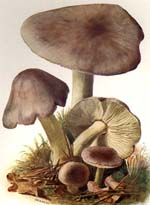Laccaria trullisata
 Key to Gilled Mushrooms Key
Key to Gilled Mushrooms KeyThis is a key to gilled mushrooms, that is, mushrooms having a definite cap with a fertile surface consisting of gills. The fruiting body usually also has a stem, although that may be lateral or absent (usually, then, the mushroom is growing from wood). You can use this key to identify mushrooms that you find.
 Agaricales Order
Agaricales OrderFruiting body containing fibers (usually in the stalk)
 White Spored Suborder
White Spored SuborderSpore print "light-colored": white or buff, sometimes tinged with pink or tan. Greenish and (except for the Russulales) yellow spore prints also go here
Stalk fibrous, not fracturing like a piece of chalk
 Tricholomataceae Family
Tricholomataceae FamilyNone of the special features distinguishing the other white-spored genera:
Gills not free, as in the Lepiotas and Amanitas
Basidia not extra-long, as in the Hygrophoraceae
Spores smooth, except for Lentinellus
 Terrestrial Trich Subfamily
Terrestrial Trich SubfamilyGrowing on the ground
 Woodland Normal Trich Tribe
Woodland Normal Trich TribeFound in woods
Not rooting
 Clitocybe-like Fungi Subtribe
Clitocybe-like Fungi SubtribeGills attached to decurrent
Coloration usually white to greyish brown, sometimes purple or with purple tones
Never with a ring of any kind
 Laccaria Genus
Laccaria GenusFruiting body often with purple colors, especially on the gills
If no purple colors, then cap warm brown and minutely scaly, and gills white
Base of stalk (sometimes entire stalk) coated with fuzzy white or purple mycelium
Stalk often with tough "shavings" or "hangnails" of fibrous tissue projecting from it
Laccaria trullisata (Ellis) Peck
Here are the characters that distinguish this species from the others in its group. For its more general characters, see higher up on the page.
If there's just a few words or a microscopic feature here, a more thorough description can be found above.
Diagnosis
- In sand dunes or very sandy soil, usually under pines
-
Cap up to 3" across, usually the only part of the mushroom to emerge from the sand; grayish purple when young, soon becoming red-brown, brown or
buff
Microscropic Characters
- Spores 14-20 x 5.5-8.5 Ám, not spiny
Comments
If anyone finds a tiny similar species:
cap up to 3/4" across, reddish brown; gills with a vinaceous tinge,
its name is Laccaria maritima, and it is worth collecting for the museum as it is presently known only from Northern Europe and Eastern Canada






 Key to Gilled Mushrooms Key
Key to Gilled Mushrooms Key Agaricales Order
Agaricales Order White Spored Suborder
White Spored Suborder Tricholomataceae Family
Tricholomataceae Family Terrestrial Trich Subfamily
Terrestrial Trich Subfamily Woodland Normal Trich Tribe
Woodland Normal Trich Tribe Clitocybe-like Fungi Subtribe
Clitocybe-like Fungi Subtribe




